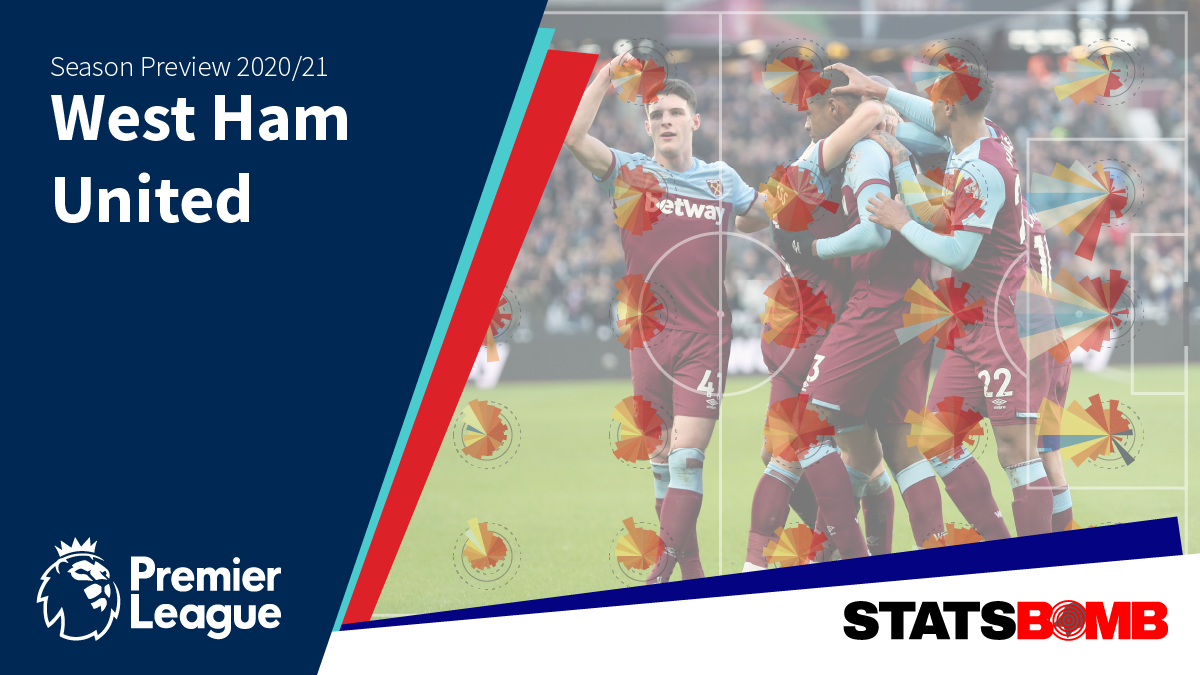In 2016-17, West Ham finished 11th with 45 points with below par metrics that roughly merited their points haul. By the start of the following November, Slaven Bilić had steered them downwards to 18th with bad metrics and a worse goal difference. He promptly exited and David Moyes was hired. Moyes did nothing for the underlying metrics (they were fairly stable at -0.5 xG per game across both managers) but eked out just enough from his team to keep them up. Moyes may have felt some displeasure at not being handed a longer tenure at that point but objectively, despite fulfilling the first remit of keeping the team in the Premier League, only a very charitable-minded review could say that he had improved his team. Mauricio Pellegrini was hired instead. In 2018-19, West Ham finished 10th with 52 points with below par metrics that did not merit their points haul. By end of the following December, Manuel Pellegrini had steered them downwards to 17th with a bad goal difference and worse metrics. He promptly exited and David Moyes was hired. Moyes did nothing for the underlying metrics (they were fairly stable at -0.6 xG per game across both managers) then the world fell apart, everyone stopped playing football and stayed in the house for three months. Pellegrini’s main issue had been a horribly open defence: the value of the shots they were giving up was higher than any other team in the league (0.13 xG/shot) and Moyes, ever the pragmatist, set about shutting that down. In the ten games before the suspension of play, West Ham recorded the lowest PPDA (pass per defensive action) value in the league (16.2). They had the deepest average defensive distance (39.8m). They were the least aggressive pressers of opponent ball receipts (19%). They had less of the ball than any other team. Translation for all that? They sat off. It had barely any effect though, as opponent shot quality remained high (0.12 xG/shot). Under either manager opponents could get nice and deep into the penalty box and grab good shots: 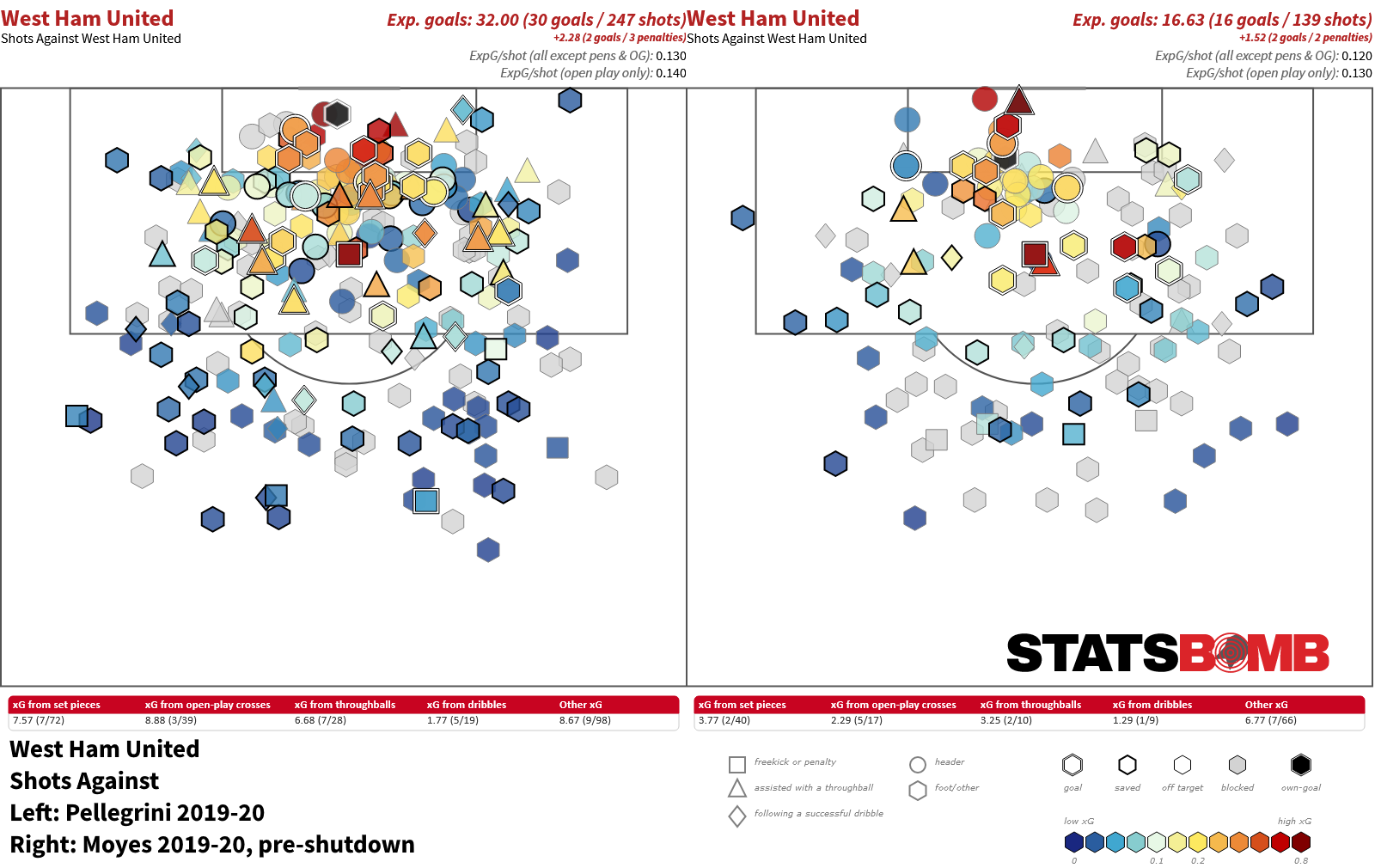 It’s an open question what may have happened to West Ham’s season had the viral intervention not occurred. The team were in sixteenth on 27 points, level with Watford and Bournemouth in seventeenth and eighteenth and with nine games left to rescue themselves from possible relegation. It's also an open question as to how reliable the form is of this concentrated post-lockdown period. Oddly, since leaving Everton and starting at Manchester United, Moyes has had four further managerial tenures, and apart from the summer of 2015 while in charge of Real Sociedad, the Covid break has been the only time he has had an extended period as a manager outside the grind of regular in season games. And given three months to prepare, Moyes managed to hit upon something that worked. The initial Moyes period did have the misfortune of some schedule stacking--they faced Liverpool twice, and Manchester City-- so there is room for some caution when considering the apparent improvement the team made, but he chopped and changed his formations in that early run, and post-lockdown stuck with a 4-2-3-1. As the season wound up, his starting eleven became more consistent too: Łukasz Fabiański in goal, a back four of Ryan Fredricks, Issa Diop, Angelo Ogbonna, Aaron Cresswell, Declan Rice and Tomáš Souček sitting, Pablo Fornals or Manuel Lanzini left, Jarrod Bowen right, Mark Noble's aging legs parked upfield as an attacking midfielder, at least in name, and Michail Antonio up front. This left a selection of expensive potential game-changers often manning the bench. Sébastien Haller, Andriy Yarmolenko and Felipe Anderson's combined cost was around £100m and they watched a good deal of football in those final weeks, occasionally, pitching in late on in games. The players that benefited most from Moyes' June reboot were the two January signings, Bowen and Souček and converted striker Antonio. Souček is a fascinating player for a central midfielder as despite many column inches being spent on the possibility of his midfield partner Rice becoming a centre back, at least from a data perspective he looks to have more centre back aligned tools. No central midfielder in the league got anywhere near his 5.1 aerial wins per 90 (next best was Phillip Billing at 3.4). He's also useful at the other end of the pitch as a goal threat in open play and from set-pieces having scored 30 goals in his last two seasons at Slavia Prague. He's added three more since arriving in England. He's a curious passer for a defensive midfielder too. Keeping the ball on the deck and playing short, he's just about secure enough (he completed over 90% of passes, still less than Rice's 95%) but as soon as he puts the ball forward and in the air it drops to 40% (down from 60% at Slavia). Quick analysis suggests that quite a lot of these failed attempts are out balls aimed at Antonio or Bowen, and Rice scopes out better at those too. Add Noble into the mix, who nominally played in the middle of the attacking midfield band as the season drew to a close, but effectively sat a lot closer to the other two defensive midfielders, and we see a clear strategy--find Antonio or Bowen if you can--that is effective only sporadically. Just 28% of high and longer passes from their own half forward and into the opponent half are finding their intended target. All this feeds into the idea of what you can get from Bowen and Antonio. Each is effective at carrying the ball deep into opposition territory (as is Felipe Anderson, moreso even, across the whole season, he ranks second behind Adama Traoré for these long carries) and are a danger to the opponent's goal:
It’s an open question what may have happened to West Ham’s season had the viral intervention not occurred. The team were in sixteenth on 27 points, level with Watford and Bournemouth in seventeenth and eighteenth and with nine games left to rescue themselves from possible relegation. It's also an open question as to how reliable the form is of this concentrated post-lockdown period. Oddly, since leaving Everton and starting at Manchester United, Moyes has had four further managerial tenures, and apart from the summer of 2015 while in charge of Real Sociedad, the Covid break has been the only time he has had an extended period as a manager outside the grind of regular in season games. And given three months to prepare, Moyes managed to hit upon something that worked. The initial Moyes period did have the misfortune of some schedule stacking--they faced Liverpool twice, and Manchester City-- so there is room for some caution when considering the apparent improvement the team made, but he chopped and changed his formations in that early run, and post-lockdown stuck with a 4-2-3-1. As the season wound up, his starting eleven became more consistent too: Łukasz Fabiański in goal, a back four of Ryan Fredricks, Issa Diop, Angelo Ogbonna, Aaron Cresswell, Declan Rice and Tomáš Souček sitting, Pablo Fornals or Manuel Lanzini left, Jarrod Bowen right, Mark Noble's aging legs parked upfield as an attacking midfielder, at least in name, and Michail Antonio up front. This left a selection of expensive potential game-changers often manning the bench. Sébastien Haller, Andriy Yarmolenko and Felipe Anderson's combined cost was around £100m and they watched a good deal of football in those final weeks, occasionally, pitching in late on in games. The players that benefited most from Moyes' June reboot were the two January signings, Bowen and Souček and converted striker Antonio. Souček is a fascinating player for a central midfielder as despite many column inches being spent on the possibility of his midfield partner Rice becoming a centre back, at least from a data perspective he looks to have more centre back aligned tools. No central midfielder in the league got anywhere near his 5.1 aerial wins per 90 (next best was Phillip Billing at 3.4). He's also useful at the other end of the pitch as a goal threat in open play and from set-pieces having scored 30 goals in his last two seasons at Slavia Prague. He's added three more since arriving in England. He's a curious passer for a defensive midfielder too. Keeping the ball on the deck and playing short, he's just about secure enough (he completed over 90% of passes, still less than Rice's 95%) but as soon as he puts the ball forward and in the air it drops to 40% (down from 60% at Slavia). Quick analysis suggests that quite a lot of these failed attempts are out balls aimed at Antonio or Bowen, and Rice scopes out better at those too. Add Noble into the mix, who nominally played in the middle of the attacking midfield band as the season drew to a close, but effectively sat a lot closer to the other two defensive midfielders, and we see a clear strategy--find Antonio or Bowen if you can--that is effective only sporadically. Just 28% of high and longer passes from their own half forward and into the opponent half are finding their intended target. All this feeds into the idea of what you can get from Bowen and Antonio. Each is effective at carrying the ball deep into opposition territory (as is Felipe Anderson, moreso even, across the whole season, he ranks second behind Adama Traoré for these long carries) and are a danger to the opponent's goal: 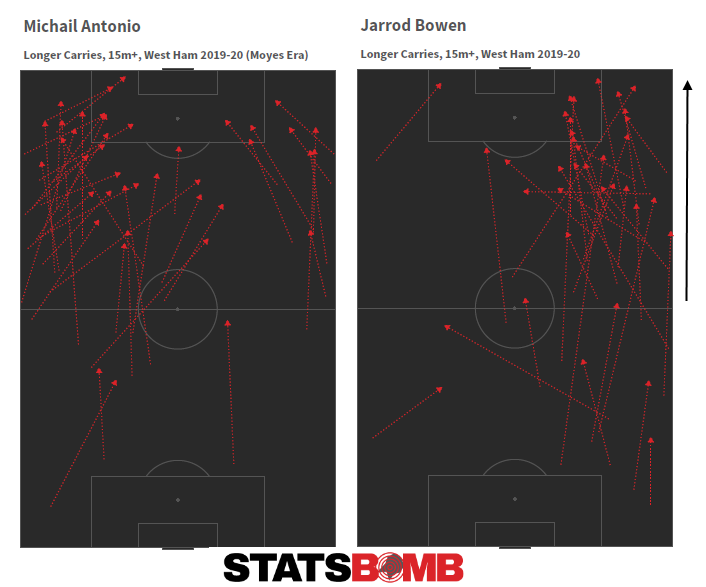 Once they have the ball, there's a good chance you'll see a shot at the end of it. One of Bowen's known weaknesses is shot selection, but from enforced turnovers, his rate of getting shots (any kind) leads the league, with Antonio not that far behind:
Once they have the ball, there's a good chance you'll see a shot at the end of it. One of Bowen's known weaknesses is shot selection, but from enforced turnovers, his rate of getting shots (any kind) leads the league, with Antonio not that far behind: 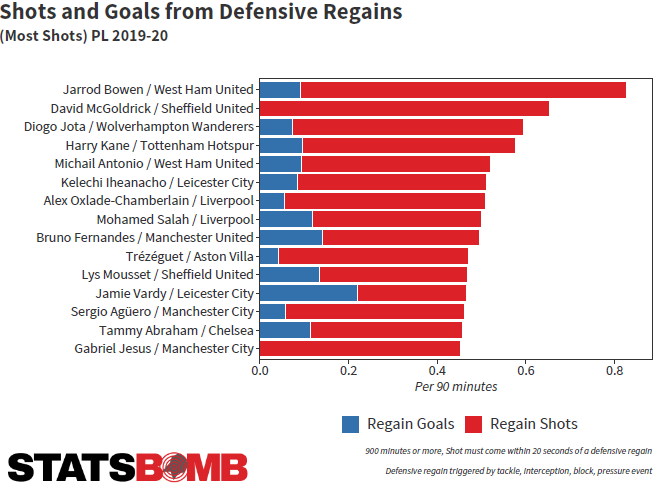 So Moyesball 2.0 is thus: defence first, a defensive midfielder with centre back qualities and an eye for goal, a converted passing defensive midfielder in the 10 slot and targeting zone movers to get the ball up the pitch and shoot. The result of this was spectacular for Antonio, who was second only to Raheem Sterling for xG per 90 after the restart. Once more reborn as a striker, he was more than a handful:
So Moyesball 2.0 is thus: defence first, a defensive midfielder with centre back qualities and an eye for goal, a converted passing defensive midfielder in the 10 slot and targeting zone movers to get the ball up the pitch and shoot. The result of this was spectacular for Antonio, who was second only to Raheem Sterling for xG per 90 after the restart. Once more reborn as a striker, he was more than a handful: 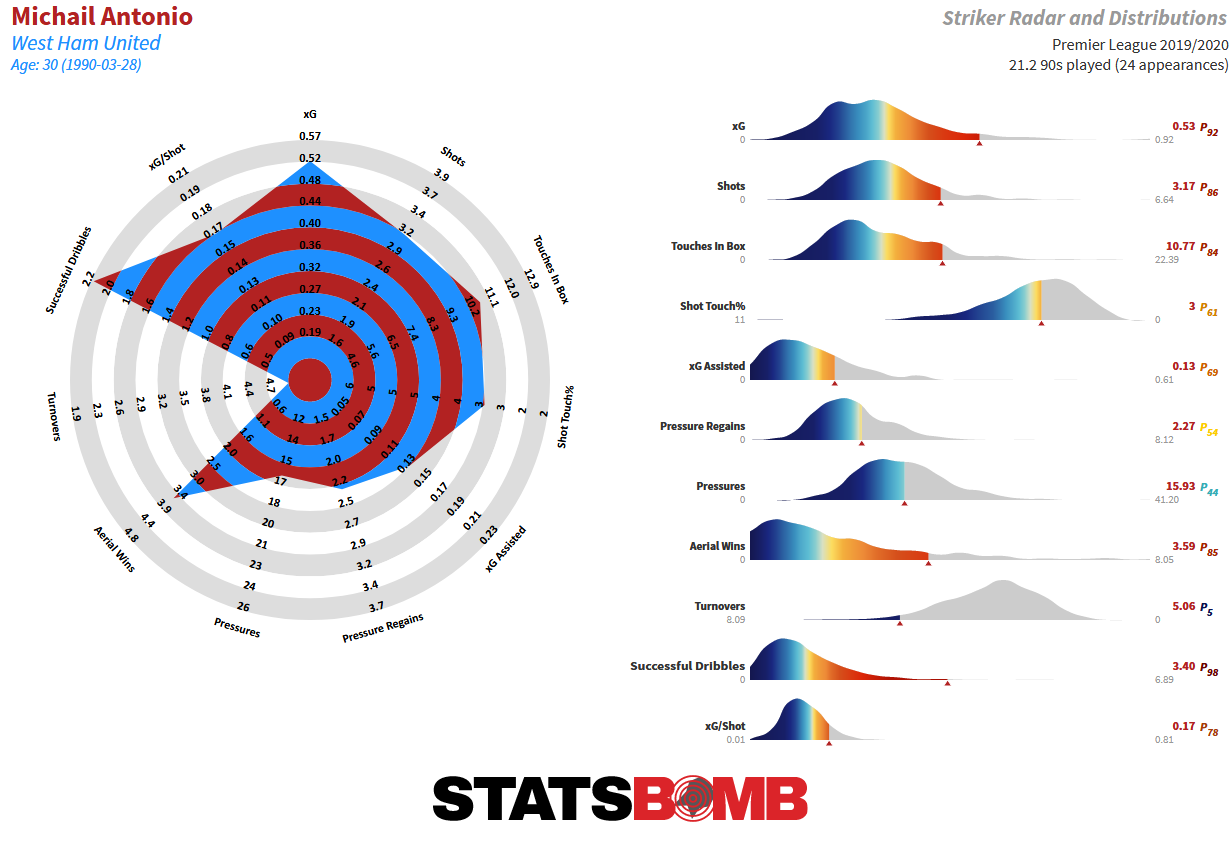 Even if we unfairly disregard his four-goal, nine shot, 2.1 xG game against Norwich, he still scopes out very well. A shade under three shots and 0.55 xG per 90 in the Moyes era is everything you want from a centre forward on a non-elite team. It will be hard to keep him out of the starting line-up when the league resumes providing an injury sustained in a warm-up match against Brentford does not persist. The period of summer football saw West Ham pick up twelve points from nine games. Not bad. But among that their metrics took a huge u-turn moving from "actually bad" to "really quite good":
Even if we unfairly disregard his four-goal, nine shot, 2.1 xG game against Norwich, he still scopes out very well. A shade under three shots and 0.55 xG per 90 in the Moyes era is everything you want from a centre forward on a non-elite team. It will be hard to keep him out of the starting line-up when the league resumes providing an injury sustained in a warm-up match against Brentford does not persist. The period of summer football saw West Ham pick up twelve points from nine games. Not bad. But among that their metrics took a huge u-turn moving from "actually bad" to "really quite good": 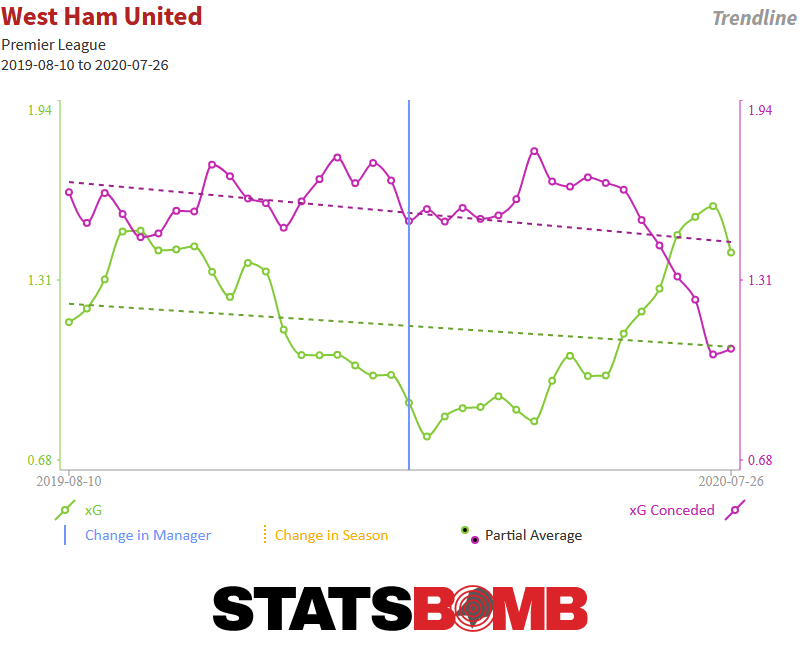 Post-lockdown xG difference was around +0.3 per 90, and goal difference matched it. The key to this defensively was the opposition shot quality finally taking a positive hit. It crashed down to 0.09 per shot. This shaved around a third off versus their season long xG Against during this period, and they also had the better end of set-pieces, scoring four and allowing just one, in line with expectation there too. Now a lot of these movements fall into the realm of possible variance within a short period of time, but West Ham haven't see this kind of positive move in metrics for a long time. At least, for now, there can be some hope that they can continue to play the style of football they provided in the summer of 2020 and be more successful, perhaps even lift themselves out of the mix for a relegation battle. Recruitment and fitness of key men may play a part in how successful that desire is. Personnel Director of Football Mario Husillos left with Manuel Pellegrini in December 2019. His record was embodied by a lot of money spent on appealing attackers, few of which have really made enough of a mark when factored against fees spent. This senior role hasn’t subsequently been publicly filled by anyone, though somebody signed off on the transfers of Bowen and Souček in January. Moyes appeared clear minded in what he wanted to do this window in an early August interview with the Evening Standard and is presumably close to the throne here, and is perhaps sitting in it: “We would like to strengthen in a lot of areas. We’re lacking in defensive cover … We’re trying to bring in a younger group but we will also need a couple of experienced players. Central defenders are usually better when they’re more experienced … Anyone who knows anything about football would surely say, ‘This is a club that could do with a period of stability.’” With the extended transfer window not shutting til October, West Ham haven't yet been active, so it's hard to get a handle on any specific recruits. Rice's future is surely more settled now that Chelsea have purchased elsewhere and in the very short term West Ham's overall squad is relatively well set for the season ahead without overt tinkering. There are aging players in the squad--Ogbonna and Noble in particular saw high minutes last season and may perhaps need extra monitoring as they enter their 33rd and 34th years--but most recent recruitment has prioritised youth or prime ages. Antonio and Cresswell are two more starters that are the wrong side of 30 now, but, as Moyes alluded, an awareness of balancing youth and experience needs to be maintained. Prediction How good is this team? In the Moyes-era overall, West Ham collected points at 40 point pace. In the Moyes-post-lockdown-period, they were better and their 12 points in 9 games was 50 point pace. Expected goals under Moyes pegs then as among the best of the rest, top of the bottom half type range, so twelfth, and the Sporting Index pre-season points prediction has them about there too. Recent spending indicates a desire to exceed the old Pulis zone (40 to 50 points) and that may be enough to set sail for better times to come, providing the owners are happy to be solid first and entertaining second, something that they haven't always appeared to endorse. You know what you will get from Moyes teams. It might not be pretty, and there's not quite enough evidence in the tank to suggest that it will definitely be effective again, but there is a route for this team to create a stable and safe outcome. They just have to commit to it and execute.
Post-lockdown xG difference was around +0.3 per 90, and goal difference matched it. The key to this defensively was the opposition shot quality finally taking a positive hit. It crashed down to 0.09 per shot. This shaved around a third off versus their season long xG Against during this period, and they also had the better end of set-pieces, scoring four and allowing just one, in line with expectation there too. Now a lot of these movements fall into the realm of possible variance within a short period of time, but West Ham haven't see this kind of positive move in metrics for a long time. At least, for now, there can be some hope that they can continue to play the style of football they provided in the summer of 2020 and be more successful, perhaps even lift themselves out of the mix for a relegation battle. Recruitment and fitness of key men may play a part in how successful that desire is. Personnel Director of Football Mario Husillos left with Manuel Pellegrini in December 2019. His record was embodied by a lot of money spent on appealing attackers, few of which have really made enough of a mark when factored against fees spent. This senior role hasn’t subsequently been publicly filled by anyone, though somebody signed off on the transfers of Bowen and Souček in January. Moyes appeared clear minded in what he wanted to do this window in an early August interview with the Evening Standard and is presumably close to the throne here, and is perhaps sitting in it: “We would like to strengthen in a lot of areas. We’re lacking in defensive cover … We’re trying to bring in a younger group but we will also need a couple of experienced players. Central defenders are usually better when they’re more experienced … Anyone who knows anything about football would surely say, ‘This is a club that could do with a period of stability.’” With the extended transfer window not shutting til October, West Ham haven't yet been active, so it's hard to get a handle on any specific recruits. Rice's future is surely more settled now that Chelsea have purchased elsewhere and in the very short term West Ham's overall squad is relatively well set for the season ahead without overt tinkering. There are aging players in the squad--Ogbonna and Noble in particular saw high minutes last season and may perhaps need extra monitoring as they enter their 33rd and 34th years--but most recent recruitment has prioritised youth or prime ages. Antonio and Cresswell are two more starters that are the wrong side of 30 now, but, as Moyes alluded, an awareness of balancing youth and experience needs to be maintained. Prediction How good is this team? In the Moyes-era overall, West Ham collected points at 40 point pace. In the Moyes-post-lockdown-period, they were better and their 12 points in 9 games was 50 point pace. Expected goals under Moyes pegs then as among the best of the rest, top of the bottom half type range, so twelfth, and the Sporting Index pre-season points prediction has them about there too. Recent spending indicates a desire to exceed the old Pulis zone (40 to 50 points) and that may be enough to set sail for better times to come, providing the owners are happy to be solid first and entertaining second, something that they haven't always appeared to endorse. You know what you will get from Moyes teams. It might not be pretty, and there's not quite enough evidence in the tank to suggest that it will definitely be effective again, but there is a route for this team to create a stable and safe outcome. They just have to commit to it and execute.
If you're a club, media or gambling entity and want to know more about what StatsBomb can do for you, please contact us at Sales@StatsBomb.com We also provide education in this area, so if this taste of football analytics sparked interest, check out our Introduction to Football Analytics course Follow us on twitter in English and Spanish and also on LinkedIn
